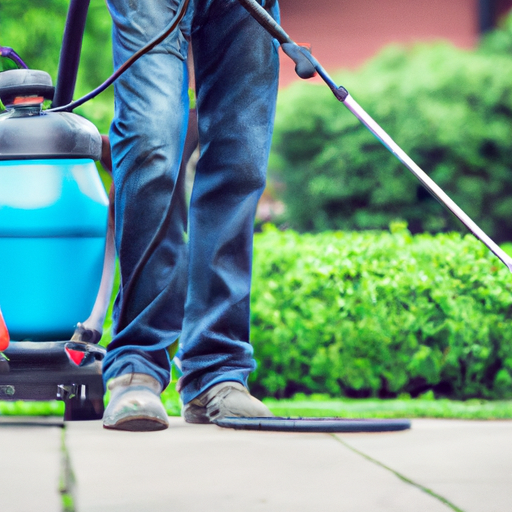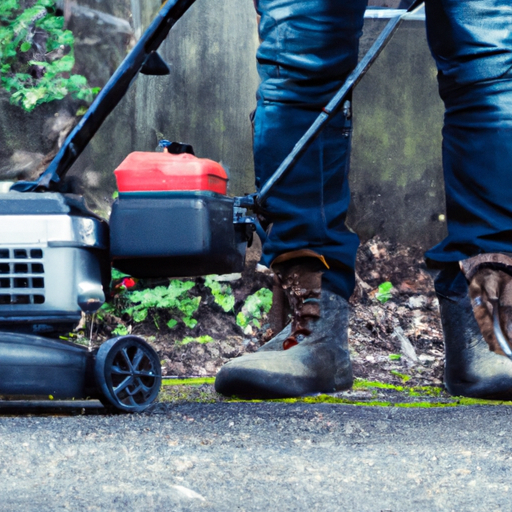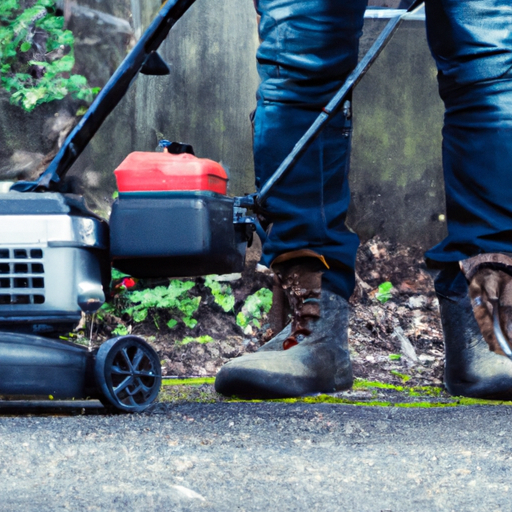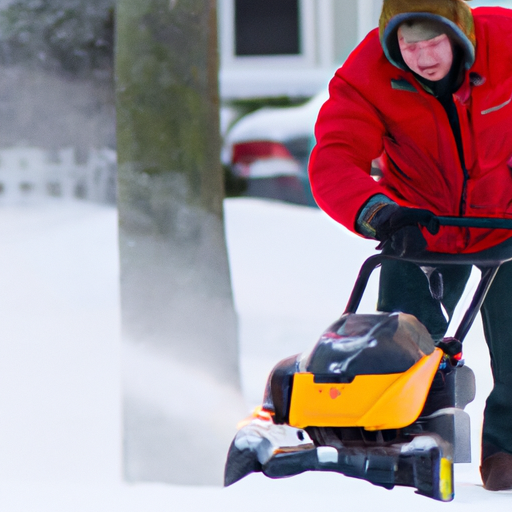Have you ever wondered about the safety precautions you should take when using a battery-powered pressure washer? Well, we’re here to help you out! In this article, we’ll discuss the important safety measures you should keep in mind to ensure a hassle-free and accident-free cleaning experience with your pressure washer. So, whether you’re a first-time user or just need a refresher, read on to find out more!
First and foremost, it’s crucial to read the user manual that comes with your battery-powered pressure washer. This may seem like a no-brainer, but it’s surprising how many people overlook this step. The user manual provides important information about assembly, operation, maintenance, and safety precautions specific to your pressure washer model. It will guide you on how to handle any potential hazards and avoid accidents.
Next, before using your battery-powered pressure washer, make sure to inspect it for any visible damages or defects. Look for any loose or damaged parts, worn-out hoses or connectors, and check the condition of the battery. If you notice any issues, it’s best to get them fixed or replaced before using the pressure washer. Remember, using a faulty machine can not only lead to inefficient cleaning but also pose serious safety risks.
When using a battery-powered pressure washer, it’s important to wear proper protective gear, such as safety goggles, closed-toe shoes, and gloves. The high-pressure water stream can cause debris to fly back at you, and using chemicals for cleaning can also be hazardous to your skin and eyes. Additionally, be cautious about the area you’re working in. Make sure it is well-ventilated to avoid inhaling fumes, and keep bystanders, including children and pets, at a safe distance. These precautions may sound simple, but they play a crucial role in keeping you and others safe while using a battery-powered pressure washer!
So, if you’re planning to use a battery-powered pressure washer, remember to prioritize safety. By following the user manual, performing a thorough inspection, and wearing appropriate protective gear, you can ensure a safe and enjoyable cleaning experience. In our next article, we’ll dive deeper into the specific safety precautions you should take when using different pressure washer accessories. Stay tuned to learn more!
Understanding Battery-Powered Pressure Washers
Battery-powered pressure washers offer a convenient and portable solution for cleaning various surfaces. These compact machines are powered by rechargeable batteries, eliminating the need for electrical outlets or gasoline. They are commonly used for tasks such as washing cars, patios, decks, and outdoor furniture. In this article, we will discuss the advantages of battery-powered pressure washers, their components, and most importantly, the safety precautions that should be taken when operating them.
Advantages of Battery-Powered Pressure Washers
-
Portability: One of the main advantages of battery-powered pressure washers is their portability. Since they do not require a direct power source, you can easily move them around without any cords or cables getting in the way.
-
Noise-free Operation: Unlike their gasoline-powered counterparts, battery-powered pressure washers operate quietly, making them suitable for use in residential areas without causing disturbance.
-
Environmentally Friendly: Battery-powered pressure washers produce zero emissions, making them an eco-friendly cleaning option. They are powered by rechargeable batteries, reducing the overall carbon footprint.
Components of a Battery-Powered Pressure Washer
To better understand battery-powered pressure washers and their safety features, it’s essential to familiarize ourselves with their components:
-
Electric Motor: The electric motor in a battery-powered pressure washer converts the electrical energy from the battery into mechanical energy, which powers the water pump.
-
Water Pump: The water pump is responsible for pressurizing the water and delivering it through the nozzle. It determines the cleaning power of the pressure washer.
-
Battery: The battery is the heart of a battery-powered pressure washer. It stores the electrical energy required to operate the machine. Different models come with different battery capacities, affecting the runtime of the pressure washer.
-
Spray Wand: The spray wand is the handheld component that directs the pressurized water onto the surface being cleaned. It usually comes with interchangeable nozzles to adjust the water spray pattern.
-
Nozzles: Nozzles determine the water pressure and spray pattern of the pressure washer. They come in various sizes and angles to cater to different cleaning needs.
General Safety Guidelines
When using a battery-powered pressure washer, it is crucial to prioritize safety. The following general guidelines should be followed to ensure a safe and accident-free cleaning experience:
Read the User Manual
Before operating the pressure washer, it is important to carefully read the user manual provided by the manufacturer. The manual contains crucial information about the correct operation, maintenance, and safety precautions specific to your pressure washer model.
Inspect the Pressure Washer
Before each use, inspect the pressure washer thoroughly. Check for any visible damage, loose connections, or leaks. If you notice any issues, do not use the pressure washer and contact the manufacturer or a qualified technician for assistance.
Wear Protective Equipment
To protect yourself from potential hazards, always wear appropriate protective equipment. This includes safety goggles or glasses, gloves, closed-toe shoes, and clothing that covers your arms and legs. Protective equipment will shield you from debris, chemicals, and high-pressure spray.
Choose a Suitable Location
Select a well-ventilated area for operating the pressure washer. Avoid enclosed spaces or areas with poor ventilation to prevent the accumulation of fumes. Additionally, ensure that the area is clear of any obstacles or tripping hazards.

Preparation
Proper preparation is key to a safe and efficient cleaning process. Before starting the pressure washer, take the following steps:
Check Battery Charge
Ensure that the battery is adequately charged before starting the pressure washer. Most battery-powered pressure washers have an indicator that shows the battery level. If the battery charge is low, charge it fully before use.
Inspect and Clean Surfaces
Before using the pressure washer, inspect the surfaces you plan to clean for any loose or damaged parts. Repair or replace them if necessary. Additionally, remove any loose debris or dirt from the surfaces to prevent clogging the pressure washer nozzle.
Clear the Work Area
Clear the work area of any objects that may interfere with your cleaning process. This includes removing furniture, toys, and loose vegetation. Keeping the work area organized will help prevent accidents and ensure a smooth cleaning experience.
Operating the Pressure Washer
When operating a battery-powered pressure washer, it is important to be mindful of proper handling techniques. The following guidelines will help ensure your safety while achieving optimal cleaning results:
Proper Handling of the Wand
Hold the spray wand firmly with both hands and maintain a stable stance. Do not use excessive force while operating the pressure washer, as it may cause loss of control. Avoid pointing the wand at yourself or others, and never place your hand in front of the spray nozzle.
Using the Correct Nozzle
Use the appropriate nozzle for the cleaning task at hand. Different nozzles have varying degrees of spray patterns, such as pinpoint, fan, or wide spray. Consult the user manual to determine the ideal nozzle for each cleaning application.
Maintaining Proper Distance from Surfaces
Maintain a safe distance from the surface being cleaned. This will help prevent damage to the material and reduce the risk of injury from flying debris. Refer to the user manual for recommended distance guidelines specific to your pressure washer model.
Avoiding Spray Towards Electrical Outlets
Do not direct the spray towards electrical outlets, switches, or any electrical components. Water and electricity are a dangerous combination and can lead to electric shock or damage to electrical systems. Take care to avoid spraying near any electrical sources.

Battery Safety
The battery is a crucial component of a battery-powered pressure washer. To ensure its safe operation, consider the following guidelines:
Use the Recommended Battery
Always use the battery recommended by the manufacturer. Using an incompatible battery can lead to performance issues, damage the pressure washer, or pose a safety risk. If you need to replace the battery, purchase one that is specifically designed for your pressure washer model.
Charging and Storing Batteries Safely
Follow the manufacturer’s instructions for charging and storing the battery. Use the designated charger provided with the pressure washer and connect it to a suitable power source. Avoid overcharging the battery, as it can cause damage. Store the battery in a cool, dry place away from flammable materials.
Avoiding Injury and Property Damage
To prevent injury to yourself and damage to property, observe the following precautions:
Avoiding Spraying People or Pets
Never spray the pressure washer at people or pets. The high-pressure water stream can cause serious injury, especially when directed at sensitive areas such as the eyes or face. Keep children and pets at a safe distance while using the pressure washer.
Preventing Damage to Fragile Surfaces
Exercise caution when cleaning fragile surfaces such as windows, delicate ornaments, or painted surfaces. High water pressure can cause damage, so adjust the pressure setting and nozzle accordingly or consider using a lower pressure setting or a wider spray pattern.
Working on Unstable Surfaces
Avoid using the pressure washer on unstable or slippery surfaces. This includes ladders, rooftops, or steep inclines. Operating the pressure washer on uneven surfaces can lead to accidents and loss of balance. Ensure that you have a stable footing to maintain control while using the pressure washer.
Protecting Nearby Plants and Objects
Cover plants, delicate objects, or any nearby items that may be sensitive to water or chemicals. Pressure washers can dislodge dirt and debris, which may damage plants or objects if they are in close proximity. Take preventative measures to protect them from harm.
Handling Chemicals
Battery-powered pressure washers often have the capability to use detergents or chemicals to enhance cleaning. Take the following precautions when handling chemicals:
Using Appropriate Detergents
Check the manufacturer’s recommendations for suitable detergents or cleaners. Some pressure washers have specific detergents designed for their use. Using unsuitable detergents can damage the pressure washer or be harmful to the environment.
Safe Handling and Storage of Chemicals
When handling chemicals, always wear protective gloves and goggles to prevent skin and eye irritation. Follow the manufacturer’s instructions for mixing and diluting chemicals. Store chemicals in their original containers in a safe and secure location, away from children and pets.
Emergency Procedures
During the operation of a battery-powered pressure washer, unforeseen circumstances may arise. It is essential to be prepared and knowledgeable about the correct emergency procedures:
Dealing with Accidental Injuries
In case of accidental injuries, respond promptly. Minor cuts or scrapes should be cleaned and treated with antiseptic ointment and bandages. For more severe injuries, seek immediate medical attention.
Addressing Mechanical Issues
If you encounter mechanical issues with your pressure washer, such as loss of pressure or unusual noises, stop using it immediately. Refer to the user manual for troubleshooting tips, or contact the manufacturer or a professional for assistance if needed.
Responding to Battery Malfunctions
If the battery malfunctions or shows signs of damage during use, disconnect it from the pressure washer. Do not attempt to repair the battery yourself. Contact the manufacturer or a professional to assess the situation and provide the appropriate solution.
Maintenance and Storage
Proper maintenance and storage of your battery-powered pressure washer will ensure its longevity and continued safe operation:
Proper Cleaning and Maintenance
After each use, clean the pressure washer by flushing it with clean water. Remove any debris or residue from the nozzles to prevent clogging. Check and tighten any loose connections, and inspect the spray wand and hose for wear or damage. Regular maintenance will help identify and address potential issues before they become more significant problems.
Storing the Pressure Washer Safely
Store the pressure washer in a dry, secure location. When not in use, disconnect the battery and store it separately. Clean and properly coil the hose, and store it away from extreme temperatures or sunlight. Follow the manufacturer’s guidelines for long-term storage to prevent damage or deterioration.
Conclusion
In conclusion, the safe operation of a battery-powered pressure washer requires a thorough understanding of the machine, proper safety precautions, and adherence to the manufacturer’s guidelines. By following the safety measures outlined in this article, you can ensure a safe and effective cleaning experience. Remember, your safety and the safety of others should always be the top priority when using any machinery or equipment.


